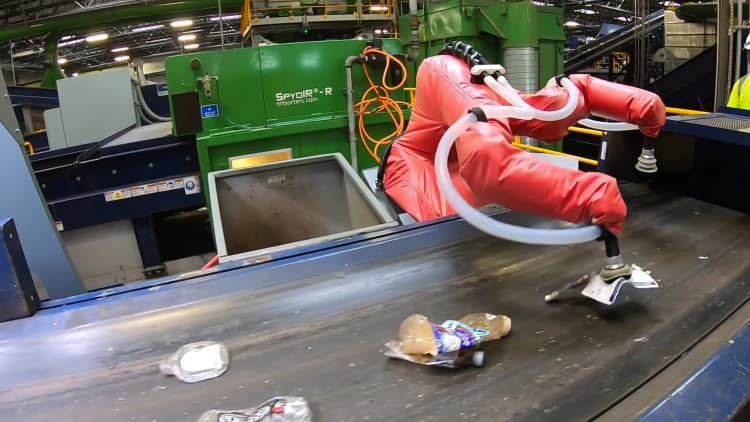
The U.S. is facing a recycling crisis that is burying cities and towns in tens of millions of tons of garbage a day. The problem began last year when China, the world's largest recyclable processor, stopped accepting most American scrap plastic and cardboard due to contamination problems, and a glut of plastics overwhelming its own processing facilities. Historically, China recycled the bulk of U.S. waste.
Contamination in the U.S. is high since recyclables are often dumped into one bin instead of multi-streamed or separated from the source. Now China has strict standards for recycling materials it will accept, requiring contamination levels in a plastic bale, for example, contain one-tenth of 1%.
The situation is dire for many local economies as recycling costs skyrocket. It's forced many cities and some small communities to stop recycling all together. Now more waste is ending up in landfills and incinerators.
To tackle this environmental catastrophe, U.S. companies and researchers are developing AI-assisted robotic technology that can work with humans in processing plants and improve quality control. The goal is to have robots do a better job at sorting garbage and reduce the contamination and health hazards human workers face in recycling plants every day. Sorting trash is a dirty and dangerous job. Recycling workers are more than twice as likely as other workers to be injured on the job, according to a report at the University of Illinois School of Public Health. The profession also has high fatality rates.
The way the robots work is simple. Guided by cameras and computer systems trained to recognize specific objects, the robots' arms glide over moving conveyor belts until they reach their target. Oversized tongs or fingers with sensors that are attached to the arms snag cans, glass, plastic containers, and other recyclable items out of the rubbish and place them into nearby bins.
The robots — most of which have come online only within the past year — are assisting human workers and can work up to twice as fast. With continued improvements in the bots' ability to spot and extract specific objects, they could become a formidable new force in the $6.6 billion U.S. industry.
Researchers like Lily Chin, a PhD. student at the Distributed Robotics Lab at MIT, are working to develop sensors for these robots that can improve their tactile capabilities and improve their sense of touch so they can determine plastic, paper and metal through their fingers. "Right now, robots are mostly reliant on computer vision, but they can get confused and make mistakes," says Chin. "So now we want to integrate these new tactile capabilities."
Denver-based AMP Robotics, is one of the companies on the leading edge of innovation in the field. It has developed software — a AMP Neuron platform that uses computer vision and machine learning — so robots can recognize different colors, textures, shapes, sizes and patterns to identify material characteristics so they can sort waste.
The robots are being installed at the Single Stream Recyclers plant in Sarasota, Florida and they will be able to pick 70 to 80 items a minute, twice as fast as humanly possible and with greater accuracy.
"Using this technology you can increase the quality of the material and in some cases double or triple its resale value," says AMP Robotics CEO Mantaya Horowitz. "Quality standards are getting stricter that's why companies and researchers are working on high tech solutions."
In the meantime, San Francisco is busy trying to get ahead of the curve in the recyclables arena. It wants to be the first city in the U.S to reach zero waste through recycling and composting so nothing goes to landfill or incineration," says Paul Giusti, the San Francisco regional government community affairs manager for Recology, a resource recovery and reuse company.
The company that runs a large plant on the San Francisco Bay just did an $11 million upgrade and plans to invest another $3 million this year in high tech optical sorter and robotics.
Waste Management, the nation's largest recycling company sees this trend intensifying throughout the country. "It's very difficult with older recycling facility assets to meet the new industry standards China and other buyers are demanding," says Brent Bell, vice president of recycling at Waste Management. "Companies and municipalities have to invest in new technology to compete."
What robotics gives you with AI is a whole new way to boost efficiency and improve safety at the plant, Bell points out. It's a new scheme that helps you monitor everything including hazardous materials, he says.
For more on tech, transformation and the future of work, join CNBC at the @ Work: People + Machines Summit in San Francisco on November 4. Leaders from Dropbox, Sas, McKinsey and more will teach us how to balance the needs of today with the possibilities of tomorrow, and the winning strategies to compete.






